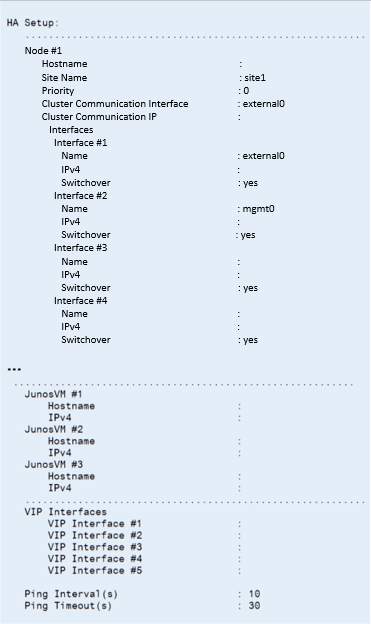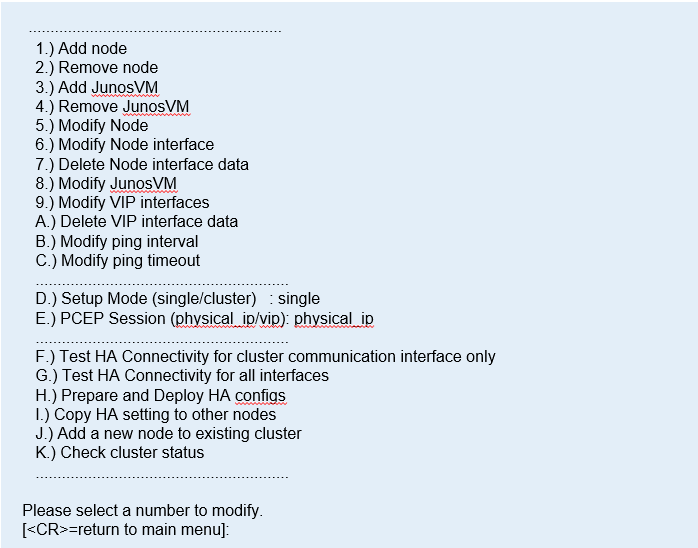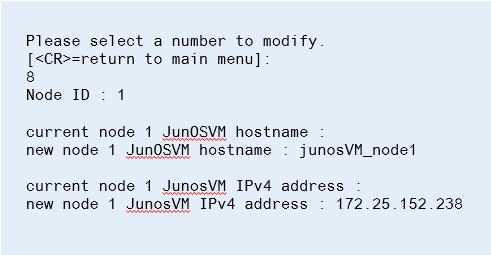ON THIS PAGE
Configuring a NorthStar Cluster for High Availability
Before You Begin
Configuring a NorthStar application cluster for high availability (HA) is an optional process. This topic describes the steps for configuring, testing, deploying, and maintaining an HA cluster. If you are not planning to use the NorthStar application HA feature, you can skip this topic.
See High Availability Overview in the NorthStar Controller User Guide for overview information about HA. For information about analytics HA, see Installing Data Collectors for Analytics.
Throughout your use of NorthStar Controller HA, be aware that you must replicate any changes you make to northstar.cfg to all cluster nodes so the configuration is uniform across the cluster. NorthStar CLI configuration changes, on the other hand, are replicated across the cluster nodes automatically.
Download the NorthStar Controller and install it on each server that will be part of the cluster. Each server must be completely enabled as a single node implementation before it can become part of a cluster.
This includes:
Creating passwords
License verification steps
Connecting to the network for various protocol establishments such as PCEP or BGP-LS
Note:All of the servers must be configured with the same database and RabbitMQ passwords.
All server time must be synchronized by NTP using the following procedure:
Install NTP.
yum -y install ntp
Specify the preferred NTP server in ntp.conf.
Verify the configuration.
ntpq -p
Note:All cluster nodes must have the same time zone and system time settings. This is important to prevent inconsistencies in the database storage of SNMP and LDP task collection delta values.
Run the net_setup.py utility to complete the required elements of the host and JunosVM configurations. Keep that configuration information available.
Note:If you are using an OpenStack environment, you will have one JunosVM that corresponds to each NorthStar Controller VM.
Know the virtual IPv4 address you want to use for Java Planner client and web UI access to NorthStar Controller (required). This VIP address is configured for the router-facing network for single interface configurations, and for the user-facing network for dual interface configurations. This address is always associated with the active node, even if failover causes the active node to change.
A virtual IP (VIP) is required when setting up a NorthStar cluster. Ensure that all servers that will be in the cluster are part of the same subnet as the VIP.
Decide on the priority that each node will have for active node candidacy upon failover. The default value for all nodes is 0, the highest priority. If you want all nodes to have equal priority for becoming the active node, you can just accept the default value for all nodes. If you want to rank the nodes in terms of their active node candidacy, you can change the priority values accordingly—the lower the number, the higher the priority.
Set Up SSH Keys
Set up SSH keys between the selected node and each of the other nodes in the cluster, and each JunosVM.
Configure the Three Default Nodes and Their Interfaces
The HA Setup main menu initially offers three nodes for configuration because a cluster must have a minimum of three nodes. You can add more nodes as needed.
For each node, the menu offers five interfaces. Configure as many of those as you need.
Configure the JunosVM for Each Node
To complete the node-specific setup, configure the JunosVM for each node in the cluster.
(Optional) Add More Nodes to the Cluster
If you want to add additional nodes, type 1 and press Enter. Then configure the node and the node’s JunosVM using the same procedures previously described. Repeat the procedures for each additional node.
HA functionality requires an odd number of nodes and a minimum of three nodes per cluster.
The following example shows adding an additional node, node #4, with two interfaces.
Please select a number to modify. [<CR>=return to main menu]: 1 New Node ID : 4 current node 4 Node hostname (without domain name) : new node 4 Node hostname (without domain name) : node-4 current node 4 Site Name : site1 new node 4 Site Name : site1 current node 4 Node priority : 0 new node 4 Node priority : 40 current node 4 Node cluster communication interface : external0 new node 4 Node cluster communication interface : external0 current node 4 Node cluster communication IPv4 address : new node 4 Node cluster communication IPv4 address : 10.25.153.12 current node 4 Node interface #2 name : mgmt0 new node 4 Node interface #2 name : external1 current node 4 Node interface #2 IPv4 address : new node 4 Node interface #2 IPv4 address : 10.100.1.7 current node 4 Node interface #2 switchover (yes/no) : yes new node 4 Node interface #2 switchover (yes/no) : current node 4 Node interface #3 name : new node 4 Node interface #3 name : current node 4 Node interface #3 IPv4 address : new node 4 Node interface #3 IPv4 address : current node 4 Node interface #3 switchover (yes/no) : yes new node 4 Node interface #3 switchover (yes/no) : current node 4 Node interface #4 name : new node 4 Node interface #4 name : current node 4 Node interface #4 IPv4 address : new node 4 Node interface #4 IPv4 address : current node 4 Node interface #4 switchover (yes/no) : yes new node 4 Node interface #4 switchover (yes/no) : current node 4 Node interface #5 name : new node 4 Node interface #5 name : current node 4 Node interface #5 IPv4 address : new node 4 Node interface #5 IPv4 address : current node 4 Node interface #5 switchover (yes/no) : yes new node 4 Node interface #5 switchover (yes/no) :
The following example shows configuring the JunosVM that corresponds to node #4.
Please select a number to modify. [<CR>=return to main menu] 3 New JunosVM ID : 4 current junosvm 4 JunOSVM hostname : new junosvm 4 JunOSVM hostname : junosvm-4 current junosvm 4 JunOSVM IPv4 address : new junosvm 4 JunOSVM IPv4 address : 10.25.153.13
Configure Cluster Settings
The remaining settings apply to the cluster as a whole.
Test and Deploy the HA Configuration
You can test and deploy the HA configuration from within the HA Setup main menu.
Replace a Failed Node if Necessary
On the HA Setup menu, options I and J can be used when physically replacing a failed node. They allow you to replace a node without having to redeploy the entire cluster which would wipe out all the data in the database.
While a node is being replaced in a three-node cluster, HA is not guaranteed.
Configure Fast Failure Detection Between JunosVM and PCC
You can use Bidirectional Forward Detection (BFD) in deploying the NorthStar application to provide faster failure detection as compared to BGP or IGP keepalive and hold timers. The BFD feature is supported in PCC and JunosVM.
To utilize this feature, configure bfd-liveness-detection minimum-interval milliseconds on the PCC, and mirror this configuration on the JunosVM. We recommend a value of 1000 ms or higher for each cluster node. Ultimately, the appropriate BFD value depends on your requirements and environment.




